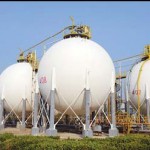 West Texas Intermediate crude fell on Tuesday ahead of a government report which may show US gasoline and distillate fuel supplies rose last week after surging by the most in 11 months in the preceding seven-day period. Upbeat manufacturing data from the US fanned positive sentiment for demand prospects but also reinforced speculations the Federal Reserve might trim its monthly bond purchases at FOMCs two-day meeting starting today after a recent series of upbeat data. The oil market, and mainly the Brent benchmark crude, drew support as manufacturing activity in the Euro zone rose to the second highest since more than two years, while ongoing supply disruptions in Libya continued to raise concerns over global supply.
West Texas Intermediate crude fell on Tuesday ahead of a government report which may show US gasoline and distillate fuel supplies rose last week after surging by the most in 11 months in the preceding seven-day period. Upbeat manufacturing data from the US fanned positive sentiment for demand prospects but also reinforced speculations the Federal Reserve might trim its monthly bond purchases at FOMCs two-day meeting starting today after a recent series of upbeat data. The oil market, and mainly the Brent benchmark crude, drew support as manufacturing activity in the Euro zone rose to the second highest since more than two years, while ongoing supply disruptions in Libya continued to raise concerns over global supply.
On the New York Mercantile Exchange, WTI crude for delivery in February fell by 0.30% to $97.57 per barrel by 8:15 GMT and held in range between $97.72 and $97.44. The US benchmark added 1.1% on Monday after settling 1.3% lower the previous week.
Meanwhile on the ICE, Brent futures for settlement in February fell by 0.31% to $109.07 a barrel and held in a range between days low of $109.02 and session high at $109.41. The European benchmark added 0.2% on Monday. Brents premium to its US counterpart was $13.12 yesterday, the widest since December 6 based on closing prices.
Futures were pressured by expectations the Energy Information Administration might report a further advance in US refined products inventories on Wednesday. The agency said last Wednesday that total motor gasoline stockpiles rose by 6.7 million barrels in the seven days to December 6, while distillate fuel inventories jumped by 4.5 million barrels last week to 118.1 million. This was the biggest gain in both the product groups since January 4.
Meanwhile, stockpiles at Cushing, Oklahoma, the biggest U.S. storage hub and delivery point for NYMEX-traded contracts, jumped by 625 000 barrels to 41.2 million, the highest since July 26. Domestic crude production surged to 8.08 million barrels per day, the highest since 1988.
According to a weekly Bloomberg News survey of analysts, gasoline supplies likely rose by 1.75 million barrels in the seven days through December 13, while distillate fuel inventories jumped by 240 000 barrels, indicating lingering demand in the worlds top consumer. Crude stocks are projected to have fallen by 3.25 million barrels, a third consecutive weekly drop.
The industry-funded American Petroleum Institute will release its separate report later today. Its data however is considered as less reliable than EIAs statistics as it is based on voluntary information provided by operators of refineries, pipelines and bulk terminals, while the government requires reports to be filed with the EIA.
Ric Spooner, a chief analyst at CMC Markets in Sydney, said, cited by Bloomberg: “Inventory figures will be important against a background of significant stockpile build-up. The market will want to see some inroads into that.”
Fed stimulus outlook
Prices were further pressured as investors remained cautious and avoided entering big positions ahead of FOMCs two-day meeting which starts today. A recent spate of upbeat economic data raised wagers that the Federal Reserve might decide to cut its $85 billion in monthly bond purchases in December, instead of waiting until March.
The latest numbers from the US showed that manufacturing activity picked up in December, while industrial production advanced for a fourth straight month in November.
The Markit Flash U.S. Manufacturing PMI posted at a solid 54.4 this month, despite slightly retreating from Novembers 8-month high of 54.7. The report showed that business conditions marked a firm improvement in December and the higher production supported the strongest gain in employment since March. The output sub-index posted at 57.3, down from 57.4, while employment surged to 53.7, compared to 52.3 in November.
Chris Williamson, Chief Economist at Markit, commented on the report: “The flash PMI remained surprisingly high in December, suggesting strong growth momentum in the goods producing sector. The PMI fell just short of the November reading, which had been buoyed by a rebound after a disrupted October. Over the fourth quarter as a whole, manufacturing has enjoyed its best performance since the start of the year.”
Meanwhile, industrial output surged for a fourth consecutive month in November, exceeding analysts projections. Production jumped by 1.1% last month, beating expectations for a moderate 0.6% advance. Octobers reading received an upward revision to 0.1% from initially estimated at -0.1%.
Yesterdays strong numbers, coupled with last weeks better-than-expected retail sales, added to the steadily building-up positive sentiment for the US economic recovery, buoyed by a larger-than-expected third quarter growth and unemployment hitting the lowest level in 5 years.
The Federal Reserve may begin to scale back its $85 billion in monthly asset purchases at the committee’s policy meeting on December 17th-18th rather than wait until January or March, according to 34% of economists who participated in a Bloomberg survey on December 6th. In November’s survey, 17% of respondents projected a tapering in December.
Support
The oil market gained support as upbeat manufacturing data from the Euro zone boosted demand prospects, particularly for the Brent benchmark. The single currency blocs preliminary manufacturing PMI jumped to 52.7 in December, exceeding projections for a minor advance to 51.9 from Novembers final reading of 51.6. This was the second highest reading in nearly 2-1/2 years.
Prices also continued to be aided by ongoing supply disruptions in Libya, the holder of Africas biggest crude reserves. The Brent benchmark fell on Friday amid expectations that the government will strike an agreement with local tribes during the weekend on reopening three export terminals that would raise exports by 600 000 bpd.
Ibrahim Al Jedran, a Libyan rebel leader, said yesterday that the ports of Es Sider, Ras Lanuf and Zueitina will remain closed after the official government rejected his demands to share oil revenue with his self-proclaimed government. Jerdan had signaled that the eastern region known as Cyrenaica may sell crude without approval, if his terms were not met, leaving Libya’s current nationwide exports at 110 000 bpd from five ports under government control. Output amounted to 210 000 barrels per day last month, down from 1.55 million bpd in 2010.





